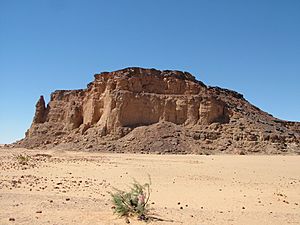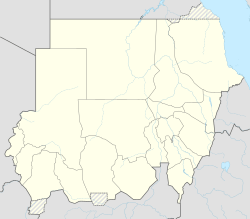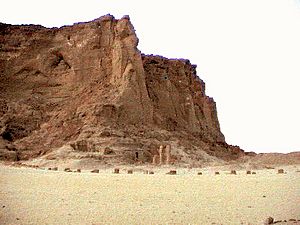Jebel Barkal facts for kids
|
جبل بركل
|
|

Jebel Barkal is a small mountain, 98 meters tall
|
|
| Alternative name | Gebel Barkal |
|---|---|
| Location | Karima, Northern State, Sudan |
| Region | Nubia |
| Coordinates | 18°32′12″N 31°49′42″E / 18.53667°N 31.82833°E |
| Type | Sanctuary |
Jebel Barkal or Gebel Barkal is a very small mountain located in Karima town in Northern State in Sudan, on a large bend of the Nile River, in the region called Nubia. The mountain is 98 m tall, has a flat top, and apparently was used as a landmark by the traders in the important route between central Africa, Arabia, and Egypt, as the point where it was easier to cross the great river. In 2003, the mountain, together with the historical city of Napata (which sits at its feet), were named World Heritage Sites by UNESCO.
Contents
History
Around 1450 BCE, the Egyptian Pharaoh Thutmose III extended his empire to that region and considered Jebel Barkal its southern limit. There, he campaigned near the city of Napata that, about 300 years later, became the capital of the independent kingdom of Kush. The 25th Dynasty Nubian king Piye later greatly enlarged the New Kingdom Temple of Amun in this city and erected his Year 20 Victory stela within it.
Ruins
The ruins around Jebel Barkal include at least 13 temples and 3 palaces, that were for the first time described by European explorers in the 1820s. In 1862 five inscriptions from the Third Intermediate Period were recovered by an Egyptian officer and transported to the Cairo Museum, but not until 1916 were scientific archeological excavations performed by a joint expedition of Harvard University and the Museum of Fine Arts of Boston.
From the 1970s, explorations continued by a team from the University of Rome La Sapienza, that was joined by another team from the Boston Museum, in the 1980s. The larger temples, such as the Temple of Amun, are even today considered sacred to the local population.
Images for kids
-
The last standing pillars of Napata's temple of Amun at the foot of Jebel Barkal
-
Lion-headed God Appademak with Pharaoh Taharqa (right) in the Jebel Barkal Temple of Mut.
-
Senkamanisken slaying enemies in front of God Amun, at Jebel Barkal (pylon of building B 700, west of the main temple).
-
Colossal statue of King Aspelta from the Temple of Amun, Jebel Barkal. Boston Museum of Fine Arts.
-
The Stele of Piye was discovered in Jebel Barkal. Cairo Museum
-
The Stele of Tantamani. Cairo Museum
-
Golden Bracelet found in the tomb of a member of the Royal Family in Gebel Barkal. Meroic period, 250-100 BCE
-
Barque stand from Temple B700 showing Atlanersa holding up the heavens, now in the Museum of Fine Arts in Boston
See also
 In Spanish: Gebel Barkal para niños
In Spanish: Gebel Barkal para niños





















